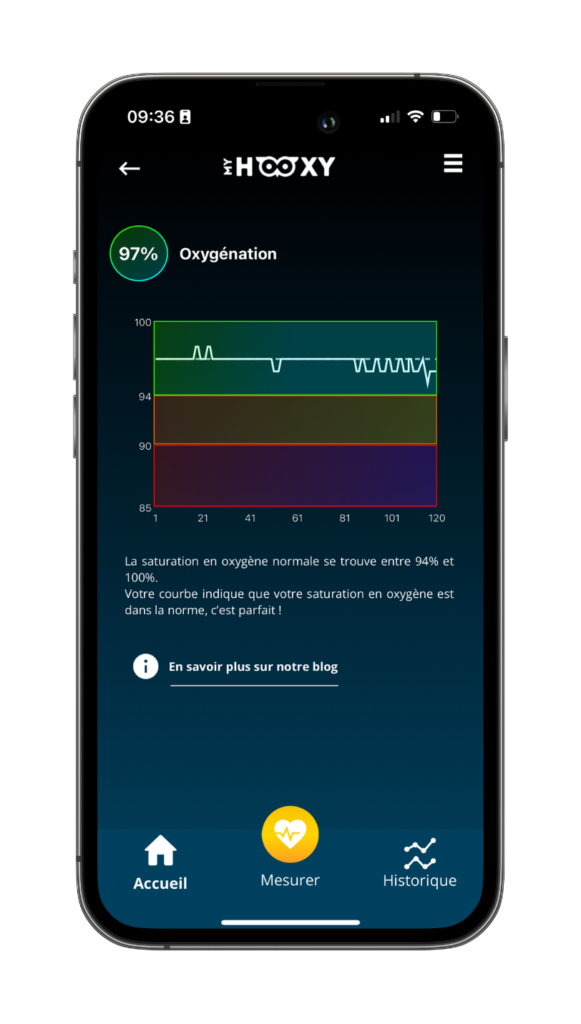
What is the oxygenation
When we talk about oxygenation, we’re talking about measuring oxygen saturation levels in the blood. You’re probably wondering what the oxygen saturation level is, and what it means for you?
Oxygen saturation levels:
Let’s not forget that blood circulation both supplies oxygen to all body tissues and transports carbon dioxide to the lungs for expulsion. This is the body’s oxygenation process.
The rate of oxygenation can be measured in two ways: Oxygen partial pressure, expressed as PaO2, and oxygen saturation, which can be expressed in one of two ways. SaO2, if measured in arterial blood, and SpO2 if measured with a pulse oximeter. We’ll concentrate here on SpO2.
SpO2 stands for Pulse Oxygen Saturation, and is a measure of the amount of oxygen present in the blood. To determine this percentage, we compare the level of oxygenated and non-oxygenated hemoglobin in the blood. This gives an estimate of the percentage of oxygenated hemoglobin in the blood.
When we inhale air, oxygen passes into the lungs and through the pulmonary alveoli, where it is absorbed by red blood cells. Oxygenated blood then circulates throughout the body, supplying oxygen to muscles, organs and other tissues.To maintain a normal SpO2, our respiratory system must be healthy and clear.A normal SpO2 is between 95% and 100%.However, SpO2 below 95% is insufficient.If the SpO2 falls below 94%, we speak of oxygen saturation insufficiency.In more serious cases, we speak of desaturation. This can occur as a result of respiratory problems on the part of the person affected, or low oxygen levels in the ambient air, as at altitude.However, there are ways of increasing oxygen saturation levels.

Exercises to improve your oxygen saturation:
First of all, it’s essential to control your breathing to ensure optimal oxygenation of the body.This involves slow, deep, regular breathing. This type of conscious breathing exploits the diaphragm muscle.Most people unconsciously breathe by lifting their chest.Belly breathing involves using the diaphragm, which is far more efficient.One of these breathing exercises is cardiac coherence.We touched on this exercise in this article.This breathing technique also improves oxygenation levels.
There’s another effective technique for increasing oxygen saturation. This consists of practicing breathing by vocalizing the exhalation. To do this, inhale through the nose for 2 to 5 seconds and exhale slowly through the mouth, producing a prolonged, airy sound. It sounds like a sort of yawn or sigh of relief. The vocalization can last from 6 to 20 seconds. There is no set frequency for this flexible exercise, which can be performed at any time at your convenience.
Finally, to improve breathing and increase oxygen saturation, relaxation techniques such as yoga can be used. However, it’s important to be supervised by a breathing coach to avoid the risk of injury, as yoga can be dangerous if the movements are intense.
Good habits for your respiratory health:
Beyond exercise, daily habits have a significant impact on oxygen saturation. To increase this value, it’s important to review your lifestyle and adopt healthy behaviors. Drinking quality mineral water on a regular basis and eating mineral-rich foods is highly recommended. For good hydration, you need around 30ml of water per kilo.
Regular exercise helps maintain good breathing and eliminate excess weight if necessary. It’s also advisable to prefer the fresh, pure air of nature to the artificial air of air conditioners, fans and urban pollution. Finally, it’s essential to eliminate harmful habits such as smoking, which is extremely harmful to the lungs and can reduce oxygen saturation. Regular smokers even run the risk of developing chronic obstructive pulmonary disease (COPD) over the long term.
For any specific problem or pathology, it’s vital to follow your doctor’s advice and recommendations.